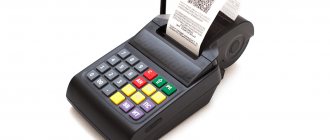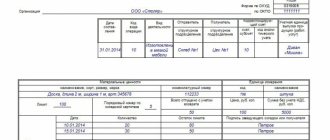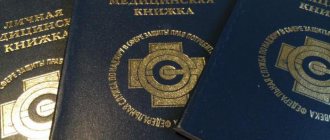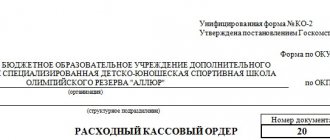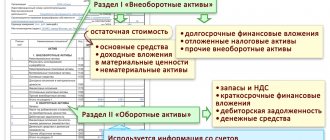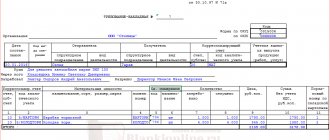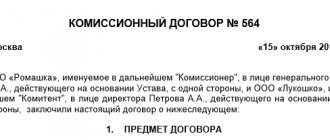An advance report is a primary document that is drawn up to report to an employee on the expenditure of money on the purchase of goods, services, and work. Let's fill out the expense report together: we will consider the entire chain of operations, the result of which will be the correct preparation of the expense report. The advance report will be available at the end of this article.
The organization must develop and approve local regulations governing the circulation of cash, including its issuance to accountable persons. Such documents are:
- regulations on settlements with accountable persons, developed taking into account the requirements of Bank of Russia Directive No. 3210-U dated March 11, 2014 (hereinafter referred to as Procedure No. 3210-U);
- a list of employees entitled to receive accountable funds, approved by the head of the organization;
- orders on business trips;
- employee’s application for the issuance of accountable amounts (indicating the account for transferring money by bank transfer).
Thus, accountable amounts are issued only in a certain order based on the order of the director of the company and/or the application of the employee.
Issuance of accountable amounts
The general procedure for issuing funds for reporting is established in clause 6.3 of Procedure No. 3210-U. Therefore, an organization can issue accountable funds in the following ways:
- cash from the cash register;
- by cashless transfer to a bank card (see Letter of the Ministry of Finance of the Russian Federation dated August 25, 2014 No. 03-11-11/42288).
Cash can be issued to employees with whom an employment contract or a civil law contract has been concluded (see Letter of the Central Bank of the Russian Federation dated October 2, 2014 No. 29-R-R-6/7859).
IMPORTANT!
Immediately before issuing funds to an employee of the enterprise's accounting department, it is necessary to check whether the employee has any debt on previously issued advances. If there is no such information (the employee has not reported on previously issued funds), he does not have the right to receive other accountable amounts (paragraph 3, clause 6.3 of Order No. 3210-U).
How to confirm expenses
Every company manager, when giving cash to an employee for any purpose, wants to receive confirmation that the money was actually used for its intended purpose. This confirmation is official documents: checks, invoices, passenger tickets, boarding passes. Each supporting document must meet certain requirements. The name of the document, the date of its execution, and the signatures of the responsible persons must be indicated here.
Surely many are familiar with the significant drawback of a cash receipt. The text printed on this document does not last long. It can fade and simply wear off. This makes the information on the check impossible to read. Naturally, in this state it is not a document that can be attached to the expense report. To avoid such problems, it is recommended to make a photocopy of the cash receipt. And if we are talking about a large sum, it would be useful to certify the copy with a seal.
In addition, you should pay attention to other nuances that you may encounter in the process of preparing an expense report:
- If supporting documents are in a foreign language, they must be translated into Russian. There is no urgent need to translate all data. Only essential information that is important for drawing up the expense report should be translated.
- There are situations when the provision of services, the purchase of goods or other expenses occur on a weekend. It must be remembered that the labor inspectorate monitors the work of employees on weekends, because this time is intended for rest. To avoid problems, it is better to make transactions on weekdays.
- The expense report form can be developed by the company independently. Naturally, it must be approved in the accounting policy. Let us remind you that since 2013 the use of the unified form AO-1 has been abolished. However, practice shows that many are quite satisfied with it, so this form is still used today to prepare an advance report.
- Legal entities have the right to settle accounts with private entrepreneurs under one agreement for an amount of up to one hundred thousand rubles. Thus, if the transaction involves the use of larger amounts, the responsible person must take care to conclude the required number of contracts with the supplier, each of which will not exceed the specified amount. But this only applies to situations where payments are made in cash. This restriction does not apply to transactions for which non-cash payments are made. As a rule, organizations use a special account or corporate card for such payments. It must be remembered that if the accountable person receives funds in this way, the procedure for preparing an advance report remains the same.
- The company can issue absolutely any amount to the accountable person. As a rule, any restrictions are established only by corporate rules. Don’t forget, even a small amount should be taken into account in the advance report.
Advance report
The 2020 advance report form remains unchanged. Do not forget that supporting documents must be attached to the advance report.
The law does not contain requirements for the mandatory use of unified forms of primary accounting documents. At the same time, each fact of economic life is subject to registration with a primary accounting document, which is determined by clause 1 of Art. 9 of Law No. 402-FZ. Organizations have the right to choose:
- independently develop report forms;
- use the unified form No. AO-1 (approved by Resolution of the State Statistics Committee of Russia dated 01.08.2001 No. 55).
An advance report in form No. AO-1 in Excel spreadsheet format is available for free at the end of the article, and an example of filling is shown in the figure below.
IMPORTANT!
All used primary documents must be approved in the accounting policy (Law No. 402-FZ, clause 4 of PBU 1/2008 “Accounting Policy of the Organization”).
After receiving the funds, the accountable person is obliged, within a period not exceeding three working days after the expiration date for which the funds were issued for the report, or from the date of return to work, to submit an advance report with attached supporting documents (clause 6.3 of Instruction No. 3210- U) to the accounting department. If the advance report is not drawn up in a timely manner, then this is a violation of cash discipline (Article 15.1 of the Code of Administrative Offenses of the Russian Federation).
Notes to accountable persons
Each accountable person must remember the following rules for drawing up an advance report:
- The document must be submitted to the company's accounting department no later than 3 business days after the end of the period specified in the application for the issuance of funds. If the period has expired due to vacation or sick leave of an employee, the advance report must be submitted within 3 days after returning to work.
- The document can be drawn up using the standardized form AO-1 or using an individual form established and confirmed in the company’s policy, independently or with the participation of an accountant. Today, modern tools allow you to do this as correctly as possible without outside help or special knowledge.
- The report must be accompanied by all documentary sources confirming the use of accountable money: invoices, receipts, checks, tickets.
If an employee submitted an expense report improperly or provided a false document confirming expenses, he may be subject to a fine under Law No. 290-FZ.
Filling procedure
Let's look at how to fill out an advance report (see sample for 2020 below). For example, the unified form AO-1 “Advance report” is suitable.
The reporting person enters data in the following fields.
Filling out the front side of form No. AO-1:
- name of the organization that issued funds on account;
- Date of preparation;
- structural subdivision;
- details of the accountable person: full name, position, tab. number;
- purpose of the advance, for example: travel expenses, household expenses. needs, etc.;
- at the bottom you should indicate the number of attached supporting documents.
Filling out the reverse side of form No. AO-1:
- all details of the supporting document(s) confirming the expenses incurred;
- the amount of expenses incurred is reflected in the column “Amount of expenses according to the report.”
An employee of the financial or accounting service checks the fields filled in by the accountable person and additionally fills in the following fields:
- number;
- information about funds issued, broken down by amount: previous advances (balance or overexpenditure); issued from the cash desk for current expenses (for reference indicating currencies);
- “spent” - the approved amount should be indicated;
- “remaining/overexpenditure”—the amount of remaining funds is calculated;
- “accounting entry” - must contain entries that will be posted upon approval of the report.
After checking the correctness of filling out the document, accuracy, as well as the intended use of the issued funds, the form is sent for approval to the head of the organization.
After approval of the expense report, on its reverse side the amounts are indicated in the column “Amount of expense accepted for accounting” indicating the accounting accounts to which the expenses of the accountable person will be attributed. The advance report and the entries on it must correspond to the entries made in the accounting registers. Next, final settlements are made with the accountable person.
The detached part of the advance report is returned to the employee. This counterfoil is proof of reporting on accountable funds.
Sample filling AO-1
How to fill out an advance report: instructions and sample filling
What is an advance report
An advance report is a document that confirms the use of an advance payment to fulfill a certain official assignment or business needs by accountable persons.
Accountable persons are employees who can receive money from an organization to pay expenses directly related to the activities of that organization. The accounting department usually has an order with a list of persons who can take money for business expenses on account.
The advance report must indicate the amount received by the accountable person and the actual expenditure. The report is supported by documents confirming expenses. Accountable persons return the balance, and in case of non-return, this amount is withheld from the salary.
Four design rules
There are four basic rules that accountants must follow when preparing expense reports:
- The format of the report is determined by the company.
The manager must approve the original form of the report by order. However, the unified form N AO-1 “Advance report” is taken as a basis.
- The manager sets a deadline for the reporting person.
After this period, the reporting person must account for the advance. He has three working days to submit the report.
- The manager sets a deadline for the accountant.
During this period, the accountant must check the report. Then the document must be submitted to either the chief accountant or the manager for approval.
- The accountant signs the report with the manager and chief accountant.
Without these signatures, the document will be considered invalid.
Mandatory details that must be in the document are indicated in paragraph 2 of Art. 9 of the Federal Law of December 6, 2011 N 402-FZ.
Using an online service for organizing electronic document management, you can simplify the preparation and execution of reports.
Filling out an advance report
The advance report is filled out in a single copy. Both the accounting department and the reporting person are involved in filling it out. The procedure for maintaining and filling out advance reports is described in Bank of Russia Directive No. 3210-U dated March 11, 2014.
Accountable person
The sequence of actions when filling out an advance report by an accountable person:
- The employee enters his full name, position and personnel number.
- The employee fills out the “Advance payment assignment” column. It should indicate the category of expenses: travel expenses, purchase of consumables for office equipment, entertainment expenses, etc.
- On the reverse side, in columns 2 to 4, the employee lists the details of documents confirming expenses, and in column 5 he writes down the amount of expenses.
Expenses can be confirmed by:
- cash and sales receipts;
- electronic checks;
- invoices;
- cash receipt orders;
- transport documents (travel tickets, coupons).
All documents that confirm expenses must be attached to the report so that the company can accept expenses for VAT deduction.
Accountant
After the accountant receives the document from the accountable person, he must perform the following algorithm of actions:
- Assign a number to the report and indicate the date the document was received.
- Fill out a tear-off receipt for acceptance of the report for inspection, containing the full name of the accountable person, details of the advance report, the amount of money issued and the number of supporting documents. The accountant issues the completed receipt to the accountable person.
- Fill out the report table with the following data:
- information about the balance or overspending on the previous advance payment;
- information about the amount of the current advance;
- the total amount of money received and spent;
- amount of balance or overspending;
- information about the accounting accounts where the reporting is reflected.
- In column 7, the accountant writes down the amounts of expenses accepted for accounting; in column 9, the debit of the account. The accountant fills out Column 8 if the employee received an advance in foreign currency.
After this, the document is approved by the manager and the remaining columns at the top of the front side are filled out.
Only a correctly completed advance report allows you to take into account the money spent in expenses and, accordingly, in tax accounting. To ensure that everything goes according to plan, you can issue memos and checklists to reporting employees. They need to print instructions for filling out the report and a list of supporting documents.
September 29, 2020
27875
Comments for the
Cackl e
Was the article helpful?
75% of readers find the article useful
Thanks for your feedback!
Supporting documents
Supporting documents can be divided into two groups:
- financial - confirm the fact of payment of funds and the expenditure of accountable amounts for their intended purpose;
- shipping documents - confirm the fact of receipt of material assets.
All supporting documents must contain the required details: name of the counterparty, date, content of the fact of economic life, quantity, cost, as well as full name, position and signature of the person who compiled the report.
Let's consider the features of filling out various types of supporting documents.
Issuance of accountable amounts in 1C 8.3 Accounting step by step.
The basis for issuing an advance may be an order or instruction from the head of the Organization, or an application from an employee. Since 2018, writing an application from an employee is not mandatory. The application is written in any form, indicating the amount and what the funds are needed for. In this case, the next step will be the signing of this document by the Director of the Organization.
Issuing an advance amount through the cash desk in the 1C 8.3 Accounting program.
We create an expense cash order in the 1C 8.3 Accounting program: 1. Sequentially open the tabs: “Bank and cash desk” - “Cash desk” – “Cash documents” – “Cash withdrawal (creation)”
2. We indicate (fill out the document):
2.1 Type of transaction: “issuance to an accountable person.”
2.2 The number and date are assigned automatically by the program.
2.3 Recipient: select from the list of employees.
2.4 Amount: indicate the required amount, starting from the basis (order or application).
2.5 Cash flow item: “issuance of accountable amounts.”
2.6 Comment: it is convenient to indicate what served as the basis for issuing an advance, for example, “order No. 124A dated July 11, 2019” or “application from an employee dated July 11, 2019.”
2.7 Account: “50.01” (automatic)
2.8 Organization: select and list if the program maintains reports on several enterprises. If there is only one Organization, it will be automatically selected.
2.9 Open the “Details of the printed form” - fill out the “ground”: write the number and date of the order from the director or the date of the application from the employee.
3. Next, click “conduct”.
4. Check the wiring generated by the program. To do this, press the “Dt/Kt” button. Postings: debit 71.01, credit 50.01.
Check: if we open the balance sheet for 71 accounts, we will see that the employee has an advance amount.
5. Go to the newly created cash receipt order and send it for printing (icon with a picture of a printer).
6. Sign the accountable person, accountant and manager.
7. The next step is to issue money to the employee.
Transfer of funds in the 1C 8.3 Accounting program from the Organization’s account to the employee’s personal account.
We create a document in 1C Accounting 8.3, issuing funds by transferring non-cash funds to the employee’s personal account.
1. Sequentially open the tabs: “Bank and cash desk” - “Bank” - “Bank statements” - “Debit from current account (creation)”. We create a new document (payment order).
2. We indicate:
2.1 Type of transaction: “transfer to an accountable person”
2.2 The date and document number are assigned automatically.
2.3 Recipient: select from the list of employees.
2.4 Amount: we deposit the required amount specified in the basis for issuing the advance.
2.5 Purpose of payment: “issuance of funds on account for the purchase of office supplies based on order No. 1020A dated July 11, 2019.”
3. Write down the document and close.
4. Next, you will need to upload a file to send to the bank, or generate a payment order directly in the online bank (in organizations, communication with the bank is configured differently).
5. After a bank statement is received from the bank with the actual debit from the Organization’s current account, the accountant posts it in the program and again goes into the document created when transferring funds, ticks “confirmed by bank statement” and attaches the payment order. Post the document.
6. The program generates transactions: debit 71.01, credit 51.
Cash receipt and strict reporting form
A cash receipt or a strict reporting form (hereinafter referred to as the SSR) confirms the actual payment (that is, the fact that the accountable person spent the money received). The forms must contain the mandatory details provided for in Art. 4.7 54-FZ.
Taking into account the specifics of their activities or the characteristics of their location, counterparties make calculations without using cash registers (clauses 2, 3, 5–7 of Article 2 of Law No. 54-FZ).
The required BSO details are:
- Name;
- series;
- BSO numbering;
- date of payment and date of registration of the BSO;
- name of the service provider indicating the tax identification number and address;
- name and cost of services;
- position, personal signature and full name. supplier employee;
- stamp (if available);
- imprint of the printing house that produced the form.
IMPORTANT!
The BSO must contain information about the printing house (name, address, TIN); The series and number of the form must be printed in a special line.
What does the accountant fill out in the expense report?
Having received the report, the accountant must check the correctness of completion and compare the data given in the table with that specified in the attached documents. The document is assigned an individual number.
At the bottom of the front side, the accountant fills out the “receipt” lines: from whom the report form was received, its number and date, the amount spent, the number of attached documents, the date the report was accepted and the accountant’s signature. The receipt completed in this way is torn off from the main part of the AO-1 form and handed over to the accountable person as a sign that the report has been accepted and verified.
On the reverse side of the form, the accountant fills out lines 7 and 8, which reflect the amount accepted for accounting, and line 9, in which the debit of the account is written where expenses incurred are written off.
Then you need to go back to the front side and fill out two small tables:
- the first reflects the amount of the balance or overspending on previous advances, if any, in the “total received” field the issued advance amount is written, in the “spent” line – the amount actually spent. If the employee spent less of the money issued, then the “balance” is filled in, if more, then the “overspend”. If there is a balance, they are transferred to the cash register using a cash receipt order; if there is an overexpenditure, then the employee is given the missing amount from the enterprise’s cash register using a cash receipt order. In case of a balance/overexpenditure, you must also fill in “the balance is paid/the balance is issued in the amount” under the tables on the front side.
- the second table complements the first; in it, the corresponding corresponding accounting accounts are placed opposite the completed lines of the first table.
Next, the expense report is approved by the manager.
Sales receipt and invoices
The sales receipt does not have a unified form. Accordingly, each organization has the right to develop forms independently. This also applies to invoices. You only need to check the form for the presence of the required details.
It should be noted that these documents are shipping documents and do not contain confirmation of payment; accordingly, they do not reduce the amount of accountable amounts, except in cases where the acquisition of goods and materials is carried out from UTII payers who do not use cash registers. In this case, confirmation of costs will be a sales receipt (see Letter of the Ministry of Finance of Russia dated January 19, 2010 No. 03-03-06/4/2, dated November 11, 2009 No. 03-01-15/10-499, dated November 6, 2009 No. 03-01-15/10-492, dated 01.09.2009 No. 03-01-15/9-436).
Where is the unified form AO-1
The form of the unified form AO-1 and instructions for filling it out were approved by Decree of the State Statistics Committee of the Russian Federation dated August 1, 2001 No. 55. You can download the form on our website.
Let us remind you that at present the use of unified forms is optional. If desired, the expense report can be drawn up on a form developed by the organization and approved by its head.
Read more about this in “Primary document: requirements for the form and the consequences of its violation .
ConsultantPlus experts spoke in detail about the nuances of preparing and submitting an advance report:
If you do not have access to the K+ system, get a trial online access for free.
Invoices and UPD
An invoice is a tax document, which in this case provides the opportunity to accept VAT as a deduction from the budget. Please note that invoices to individuals purchasing goods (work, services) for cash are issued only if they have a power of attorney to receive this form (clause 7 of Article 168 of the Tax Code).
The universal transfer document is both a tax and shipping document. According to the UPD, you can simultaneously accept inventory items and take VAT into account for deduction from the budget.
An invoice and UPD are not documents confirming payment of material assets, and accordingly, they do not reduce the amount of accountable amounts.
IMPORTANT!
In 2020, new forms of invoice and UPD were introduced!
New invoice and UPD formats have been approved Supporting documents for individual transactions
The procedure for documenting travel and hospitality expenses requires special consideration. Below we note the key points for these cost groups.
Travel expenses
After the amendments adopted by Government Decree No. 749 “On the specifics of sending employees on business trips” (hereinafter referred to as Decree No. 749) come into force, the forms of a travel certificate, official assignment and report on work performed on a business trip are not required to be filled out. Organizations have the right to stipulate in local regulations the need to fill out these forms.
If the organization decides not to use travel certificates, then to confirm the daily allowance it is necessary to attach a free-form accounting certificate to the advance report for the business trip. The form of the certificate should be approved as part of the accounting policy.
The legislation does not limit the amount of payments in the form of daily allowances to employees of the organization. The amount of daily allowance payment should be approved by order or indicated in the regulations on travel expenses. Daily allowances are exempt from payment of insurance premiums in an amount not exceeding 700 rubles for each day of being on a business trip in the Russian Federation, and no more than 2,500 rubles for each day of being on a business trip abroad (clause 2 of Article 422 of the Tax Code). In the same amount, daily allowances are not included in the employee’s income when calculating personal income tax (clause 3 of Article 217 of the Tax Code of the Russian Federation).
We should not forget that when traveling to an area where the employee has the opportunity to return home every day, or when sending an employee on a one-day trip, daily allowances are not paid (clause 11 of Resolution No. 749).
E-ticket
The advance report for the 2020 business trip must be filled out taking into account the opinion of the Ministry of Finance set out in letter No. 03-03-06/1/35214 dated 06/06/2017. This letter clarifies that if an airline ticket is purchased electronically, the electronic ticket receipt and boarding pass are the documentary evidence for income tax purposes.
In this case, the boarding pass must confirm the fact of air transportation services to the accountable person. As a rule, this requisite is an inspection stamp.
If there is no inspection stamp on the printed electronic boarding pass, the taxpayer must confirm the fact that the accountable person has provided air transportation services in another way.
Accounting for services provided by carriers
Very often, a luxury travel ticket includes the cost of services (meals, basic necessities and hygiene items, including bedding, printed materials, etc.).
The Ministry of Finance in letter No. 03-03-РЗ/37488 dated June 16, 2017 explained how the cost of additional services is taken into account.
The cost of additional services when traveling in luxury cars is not subject to personal income tax (clause 3 of Article 217 of the Tax Code).
For the purposes of taxing the profits of organizations, the cost of additional services is taken into account entirely as part of other expenses (clause 12, clause 1, article 264 of the Tax Code).
But regarding VAT, the opinion is the opposite: if the amount of additional fees and services is formed taking into account the cost of food services, the amount of VAT is not deductible (clause 7 of Article 171 of the Tax Code of the Russian Federation).
Entertainment expenses
None of the current regulations contains instructions on the volume and procedure for processing entertainment expenses. Based on this, the organization must independently develop and approve in its accounting policies or a special regulatory act a list of supporting documents that confirm the validity and business purposes of entertainment expenses made by accountable persons.
To correctly reflect the costs of receiving and servicing Russian and foreign delegations, we recommend drawing up the following documents (see Letters of the Ministry of Finance No. 03-03-06/4/26 dated 03.22.2010 and No. 03-03-06/1/807 dated 11.13.2007 ):
- an order appointing a commission to verify the legality of writing off entertainment expenses;
- general estimate for receiving a delegation signed by the head of the organization indicating the person responsible for receiving the delegation and a list of expenses (detailed);
- a document indicating: the purpose of the delegation’s arrival (for example, an invitation), the meeting program, the composition of the delegation indicating the positions of both the invited party and the organization;
- a certificate of spent souvenirs or samples of finished products indicating what, to whom and how much was awarded;
- calculation of the buffet service performed: indicating the type of products, price, quantity and total amount, signed by the person in charge and the person who served the table.
Documents confirming the purchase of products, souvenirs and other inventory items must be attached to the reports.
IMPORTANT!
Representation expenses include expenses in an amount not exceeding 4% of the taxpayer’s expenses for wages for the reporting (tax) period. The following expenses are not recognized as entertainment expenses:
- expenses for organizing entertainment;
- vacation-related expenses.
The date of recognition of entertainment expenses issued through an accountable person is the date of approval of the advance report by the head of the organization.
To confirm business expenses in tax accounting, accountants fill out an advance report. If the document is filled out incorrectly, the Federal Tax Service may assess additional taxes.
What is an advance report
An advance report is a document that confirms the use of an advance payment to fulfill a certain official assignment or business needs by accountable persons.
Accountable persons are employees who can receive money from an organization to pay expenses directly related to the activities of that organization. The accounting department usually has an order with a list of persons who can take money for business expenses on account.
The advance report must indicate the amount received by the accountable person and the actual expenditure. The report is supported by documents confirming expenses. Accountable persons return the balance, and in case of non-return, this amount is withheld from the salary.
Four design rules
There are four basic rules that accountants must follow when preparing expense reports:
- The format of the report is determined by the company. The manager must approve the original form of the report by order. However, the unified form N AO-1 “Advance report” is taken as a basis.
- The manager sets a deadline for the reporting person. After this period, the reporting person must account for the advance. He has three working days to submit the report.
- The manager sets a deadline for the accountant. During this period, the accountant must check the report. Then the document must be submitted to either the chief accountant or the manager for approval.
- The accountant signs the report with the manager and chief accountant. Without these signatures, the document will be considered invalid.
Mandatory details that must be in the document are indicated in paragraph 2 of Art. 9 of the Federal Law of December 6, 2011 N 402-FZ.
Using an online service for organizing electronic document management, you can simplify the preparation and execution of reports.
Filling out an advance report
The advance report is filled out in a single copy. Both the accounting department and the reporting person are involved in filling it out. The procedure for maintaining and filling out advance reports is described in Bank of Russia Directive No. 3210-U dated March 11, 2014.
Accountable person
The sequence of actions when filling out an advance report by an accountable person:
- The employee enters his full name, position and personnel number.
- The employee fills out the “Advance payment assignment” column. It should indicate the category of expenses: travel expenses, purchase of consumables for office equipment, entertainment expenses, etc.
- On the reverse side, in columns 2 to 4, the employee lists the details of documents confirming expenses, and in column 5 he writes down the amount of expenses.
Expenses can be confirmed by:
- cash and sales receipts;
- electronic checks;
- invoices;
- cash receipt orders;
- transport documents (travel tickets, coupons).
All documents that confirm expenses must be attached to the report so that the company can accept expenses for VAT deduction.
Accountant
After the accountant receives the document from the accountable person, he must perform the following algorithm of actions:
- Assign a number to the report and indicate the date the document was received.
- Fill out a tear-off receipt for acceptance of the report for inspection, containing the full name of the accountable person, details of the advance report, the amount of money issued and the number of supporting documents. The accountant issues the completed receipt to the accountable person.
- Fill out the report table with the following data:
- information about the balance or overspending on the previous advance payment;
- information about the amount of the current advance;
- the total amount of money received and spent;
- amount of balance or overspending;
- information about the accounting accounts where the reporting is reflected.
- In column 7, the accountant writes down the amounts of expenses accepted for accounting; in column 9, the debit of the account. The accountant fills out Column 8 if the employee received an advance in foreign currency.
After this, the document is approved by the manager and the remaining columns at the top of the front side are filled out.
Only a correctly completed advance report allows you to take into account the money spent in expenses and, accordingly, in tax accounting. To ensure that everything goes according to plan, you can issue memos and checklists to reporting employees. They need to print instructions for filling out the report and a list of supporting documents.
All news 0

